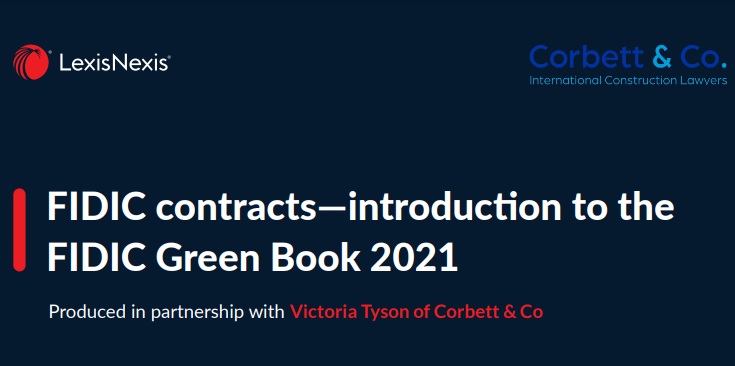Cherry Picking FIDIC 2017
Written by Edward Corbett |
October 29, 2018
Much has been said about the new Red, Yellow and Silver Books 2nd Editions launched by FIDIC in December last year. The most obvious comment has been about their size, almost 50,000 words, which is some 60% longer than the 1999 forms.
Although the 1999 forms were not perfect, most regular users seem to be agreed that they did not need 20,000 words to fix the issues. This consensus led this author to attempt to cherry-pick the good bits from the 2017 forms and to propose amendments to add the good ideas to the 1999 forms. The amendments apply to all three forms unless it is indicated otherwise.
Reasonable Profit: any reduction in the number of occurrences of the word “reasonable” is to be applauded, given the scope for argument that the word introduces. The World Bank introduced a definition of reasonable profit into its documents and the Pink Book SBD form.
1.2 Add: “(e) references to reasonable profit shall mean the percentage of Cost stated in the Appendix to Tender”.
Add to Appendix to Tender: “Reasonable profit … 1.2(e) … __% or, if none is stated, 5%”
Approval for Engineer’s Actions: the 1999 forms did not make clear whether the Employer could insist on pre-approving determinations under clause 3.5. Many assumed they could not; but FIDIC’s Guide to the 1999 form said otherwise. The 2017 forms put the matter beyond doubt, introducing a new requirement for the Engineer to act “neutrally” when making determinations.
3.1 Add in third paragraph after “undertakes”: “not to require approval for a determination under Sub-Clause 3.5 [Determinations] and”.
3.5 Red and Yellow only. Replace “the Engineer shall consult” with “the Engineer shall act neutrally and shall consult”.
Prompt Notice of Variations: the 1999 drafters slipped up by not explicitly requiring prompt notice of instructions that the Contractor considers to be Variations. This has led to problems with unhappy employers blaming their engineers for inadvertently incurring additional costs. The notice requirement gives employers and engineers an opportunity to reconsider an instruction.
3.3 Red and Yellow: Add after second sentence: “If the Contractor considers that an instruction constitutes a Variation, the Contractor shall immediately, and before commencing any work related to the instruction, give a notice to the Engineer with reasons. If the Engineer does not respond within 7 days confirming, revoking or varying the instruction, the Engineer shall be deemed to have revoked the instruction.”
3.4 Silver: Add after second sentence: “If the Contractor considers that an instruction constitutes a Variation, the Contractor shall immediately, and before commencing any work related to the instruction, give a notice to the Employer with reasons. If the Employer does not respond within 7 days confirming, revoking or varying the instruction, the Employer shall be deemed to have revoked the instruction.”
Definition of Fitness for Purpose: the 1999 form required the Works to be fit for the purposes as defined in the Contract. This caused problems when secondary elements of the work did not function properly. The primary purpose of the project may have been defined but no one will define the purpose of each and every element, rendering the fitness for purpose obligation less than useful. So some general wording was needed.
4.1 Red: Add to (c) after “Contract”: “(and each element of the part shall be fit for its ordinary purpose)”
Yellow and Silver: Add at end of first paragraph after “Contract”: “(and each element of the Works shall be fit for its ordinary purpose)”.
Cap on Delay Damages: it seemed anomalous that the limitation of liability in clause 17.6 should not apply in cases of fraud, etc. but that the cap on delay damages should apply regardless. Some contractors exploited this when the delay damages had reached their maximum and the Employer had no realistic option of termination: resources were transferred to other, more profitable projects and there was little that the Employer could do.
8.7 Add at the end of the first paragraph: “other than in the case of fraud, deliberate default or reckless misconduct by the Contractor.”
Enforcement of DAB Decisions: it was a major shortcoming of the 1999 forms that there was no clear sanction where a party, usually the Employer, failed to pay the DAB Decision. Despite the obligation to comply set out in clause 20.4, there was little that the party winning the DAB could do; and thus little incentive on the loser to pay. Rights of suspension and termination were needed.
15.2 Add: “(g) fails to give effect promptly to a decision of the DAB in accordance with Sub-Clause 20.4 [Obtaining the Dispute Adjudication Board’s Decision]”.
16.1 Add after “Sub-Clause 14.7 [Payment]”: “or fails to give effect promptly to a decision of the DAB in accordance with Sub-Clause 20.4 [Obtaining the Dispute Adjudication Board’s Decision]”.
In the first and third paragraphs, add after “evidence or payment”: “or the Employer has given effect to the decision of the DAB”.
16.2 Add to Red and Yellow: “(h) the Employer fails to give effect promptly to a decision of the DAB in accordance with Sub-Clause 20.4 [Obtaining the Dispute Adjudication Board’s Decision]”. For Silver Book, it is (g).
Some employers argued that giving a notice of dissatisfaction relieved them of the obligation to give effect to the decision. It makes sense to put the matter beyond doubt.
20.4 In fourth paragraph after “who shall promptly give effect to it” add: “whether or not notice of dissatisfaction has been given under this Sub-Clause”.
The right of a party to go to arbitration and ask for an immediate award enforcing the DAB decision has been much debated due to the language of clause 20.7. FIDIC issued a memorandum recommending an amendment to the clause; in 2017, the clause was further refined.
20.7 Replace clause with:
“In the event that a Party fails to comply with any decision of the DAB, whether binding or final and binding, then the other Party may, without prejudice to any other rights it may have, refer the failure itself directly to arbitration under Sub-Clause 20.6 [Arbitration] in which case Sub-Clause 20.4 [Obtaining DAB’s Decision] and Sub-Clause 20.5 [Amicable Settlement] shall not apply to this reference. The arbitral tribunal shall have the power, by way of summary or other expedited procedure, to order, whether by an interim or provisional measure or an award (as may be appropriate under applicable law or otherwise), the enforcement of that decision.”
Mechanism for Termination and Cure Period: the 1999 forms were ambiguous about whether termination required one notice or two: whether termination occurred automatically on the 14th day after the notice of termination; or whether a second action was required from the party terminating in order to complete the termination. The 2017 editions made it clear that two actions are required. A second uncertainty was whether action by the defaulting party within the 14 days to remedy the breach could stop the termination; in other words, was the 14 days a cure period. The 2017 forms resolve this by making it clear that the right to termination is lost if the fault has been corrected during the notice period. Although there are arguments both ways as to how these two ambiguities should have been resolved, the most important thing is to resolve them.
15.2 After “may” in line 1 of the second paragraph, replace the remaining text of that sentence with: “give 14 days’ notice of his intention to terminate the Contract. Thereafter, the Employer may forthwith terminate the Contract and expel the Contractor from the Site by giving a second notice to that effect, provided that in the case of sub-paragraphs (a) to (d) and (g) the default has continued until the date of the issue the second notice.”
16.2 Add to the first sentence of the second paragraph: “by giving a second notice, provided in the case of sub-paragraphs (a) to (e) and (h) that the default has continued for the notice period”. For Silver Book, replace (h) with (g).
After “may” in line 1 of the second paragraph, replace the remaining text of that sentence with: “give 14 days’ notice of his intention to terminate the Contract. Thereafter, the Contractor may forthwith terminate the Contract by giving a second notice to that effect, provided that in the case of sub-paragraphs (a) to (e) and (h) the default has continued until the date of issue of the second notice.” For Silver Book, replace (h) with (g).
Time Bars: the clause 20.1 28-day notice of claim caused a good deal of unnecessary misery and dispute due to its intended black-and-white nature and the unintended difficulty and discrepancy of its drafting. The drafters of the 2017 forms have unfortunately increased the number of time-bars from two to five; but they have also blunted the harsh edges of two of them by allowing the Engineer and DAB to waive them in certain circumstances.
20.1 Add to the second paragraph after “28 days”: “and (a) there are no circumstances which justify such failure and (b) the Employer can demonstrate material prejudice as a result of such failure”.
Appointment of DABs: a lot of difficulty arose when one party refused to cooperate in the appointment of a DAB member. Where FIDIC stepped in and nominated the member but the party then refused to sign the member’s Dispute Adjudication Agreement, then what? Could the DAB proceed and produce a valid decision or not? This uncertainty added to the problems of the DAB system.
20.3 Add at end: “Both Parties and each appointed member shall promptly sign or shall be deemed to have signed the Dispute Adjudication Agreement provided by the member, under which:
(i) the monthly services fee and daily fee shall be as stated in the terms of the appointment; and
(ii) the law governing the Dispute Adjudication Agreement shall be the governing law of the Contract defined in Sub-Clause 1.4 [Law and Language].
Absence of a DAB: in 1999, the drafters of clause 20.8 considered that if a DAB had existed and had resigned or their agreements had expired, then it should be possible for the parties to go to arbitration directly. They probably thought that the clause would normally apply after the work was complete, when quick, interim dispute resolution was less important. In fact, the clause – which referred to when a DAB was not “in place” due to expiry “or otherwise” – was invoked in the common circumstance when no DAB had ever been appointed. Parties to Yellow and Silver contracts were not obliged to appoint a DAB until a dispute arose; Red book parties often did not comply with the obligation to appoint at commencement.
It might therefore be a good idea to consider limiting the DAB provisions so that they become optional after taking-over has been certified. However, no change was introduced by the 2017 forms. For simplicity, the following amendment is recommended:
20.8 Delete this Sub-Clause.


